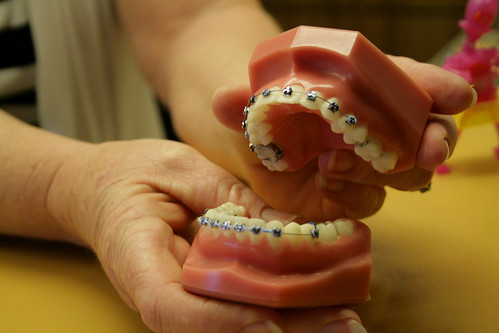Different Types of Braces for Teeth
Published by Nanni on Wednesday, August 01, 2012
Photo credit by instafoto
Robert was surprised when a coupon book fell out of the envelope along with his copy of a signed contract. Looking further, he discovered the payment coupons from his orthodontist were amazingly like those for his car payment.
There was a basic difference, however. He would end up paying for his car for four years. His daughter’s orthodontic treatment was spread over 10 years, starting at age 7.
Braces for teeth have become an almost expected part of American life, at least for children. Their popularity among adults is also growing. One type of orthodontic treatment is interventional. It seeks to ward off potential problems down the road. The other treatment is corrective. It usually involves correcting a bite.
Typically braces align crooked teeth. They also correct an under- or overbite. In some patients, they accomplish both. While treatment used to be provided only by an orthodontist, some dentists are now able to fit specific types of braces such as Invisalign.
There are five types of braces available in the United States:
Metal - They are the traditional braces and still the most common. The orthodontist uses dental cement to attach small metal brackets to each tooth, and then wires the brackets together. Patients need to return every few weeks for adjustments that cause the teeth to move closer to the proper position. Elastic bands typically connect and adjust upper teeth in relation to those in the lower half of the mouth. They usually come in various color choices for a little customization. Individuals who have metal braces are normally in them for two years.
Gold - Their appearance is very much like metal braces. However, since their brackets have a gold coating, they have a gold instead of silver appearance. Their purpose is the same as metal braces. The only difference is the patient’s color preference of gold over silver.
Ceramic - Orthodontists attach larger brackets than those used in metal braces to each tooth. The brackets are mostly clear, which makes it harder to spot them. They are also more fragile than those used with other braces. This means that they have a higher risk of breakage and of problems with oral hygiene. For this reason, patients who choose ceramic braces must follow a regimen of regular flossing and brushing.
Invisible - Invisalign is the best-known type. Invisible braces are made of clear plastic and designed to correct minor problems. Individuals who opt for this type of treatment are supposed to wear these plastic aligners at least 19 hours each day. Patients receive a set every two weeks. Each set moves the teeth by a small amount. To anchor Invisalign aligners, the orthodontist or dentist typically attaches small white temporary buttons to the teeth. This type of braces for teeth is more expensive than others, and requires a course of treatment from six months to two years long. Patients must remove their aligners to chew or swallow anything except water. Because they can remove the devices on their own, it is much easier to brush and floss the teeth than it is with other types of braces.
Lingual - These braces are harder to see than their metal cousins because they attach to the back of the patient’s teeth, not the front. Individuals who are on camera a lot prefer them because they are harder to see than other types of visible braces. Musicians often opt for this type because it is possible to play wind instruments after being fitted with them. Overall, installation takes longer than with other types of braces.
 | Posted in »
| Posted in »

0 comments: Responses to “ Different Types of Braces for Teeth ”